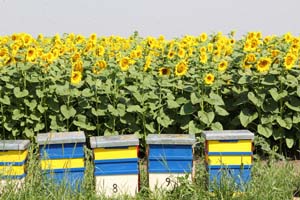How to Find Food for the Bees at Flowers by the Sea

Forgive the bad pun, but we almost wouldn't be without bees. These tiny pollinators make it possible for us to eat and experience the flowering beauty of the world around us. Without pollination, flowers don't produce fruits, vegetables or nuts such as almonds.
According to the U.S. Department of Agriculture and the Food and Agriculture Organization of the United Nations (FAO), bees pollinate at least one-third of the plant species we eat. These workers include honeybees (Apis mellifera) -- the kind managed by beekeepers -- and thousands of wild species.
It used to be that it was mostly graceful butterflies and hummingbirds receiving center-stage attention in wildlife gardening articles. But in recent years, gardeners have become more aware of how important it is to help the bee family (Apis)-- a complicated team of more than 25,000 species worldwide.
Finding Food for the Bees
FBTS specializes in growing long flowering Salvias and companion plants that are rich in nectar and pollen as well as being tolerant of drought. Many of these plants are honeybee favorites.
We know this because we observe bees working our plants daily. Many are residents of the honeybee colonies that we manage.
To improve our service to these hard workers, we make it easy for you to find plants that are bee favorites. Bees are one of the main pollinators of Salvias, so they have their own category in our catalog menu atop the FBTS homepage.
Food loss, both through drought and climate change, is one of many factors that bee researchers say is likely contributing to the decline of managed and wild bees.
The Häagen-Daz Honey Bee Haven of the University of California, Davis, in July 2014 reported that "few plants show their value as bee plants for hot, dry gardens better than the salvias."
Selecting Tasty Blossoms
Most of the Salvias and companion plants that we grow at FBTS are long blooming. Many tolerate drought and are adaptable to a broad range of growing conditions as long as they are planted in well-drained soil.
Here are few of the many FBTS plants that bees regularly visit in our gardens:
- Bee's Bliss Sage (Salvia x 'Bee's Bliss') -- A fine groundcover for USDA Cold Hardiness Zones 8 to 11
- Wild Thing Autumn Sage (Salvia greggii 'Wild Thing') -- An airy, cold-tolerant subshrub full of pink lemonade blossoms for Zones 6 to 10 and
- Lilac Sage (Salvia verticillata) -- A smoky lavender cloud of blossoms for Zones 4 to 9.
Getting Ready to Answer Questions
To help you help the bees, we also provide bee-related articles in our Everything Salvias Blog, including topics such as types of bees, how different bees' tastes vary in the plants they pollinate, current research about the decline of bees, and how you can help bees by avoiding pesticides and herbicides.
All of us can have a beneficial impact by growing favorite bee plants and resorting to biological instead of chemical control of pests and plant diseases in our gardens.
If you want advice about planning a wildlife garden that will bring on the buzz or if you have questions about any of our plants, please call or email us. We're happy to help you help the world of pollinators.

 Salvia verticillata
Salvia verticillata  Salvia greggii 'Wild Thing'
Salvia greggii 'Wild Thing'  Salvia x 'Bee's Bliss'
Salvia x 'Bee's Bliss'
Comments
There are no comments yet.